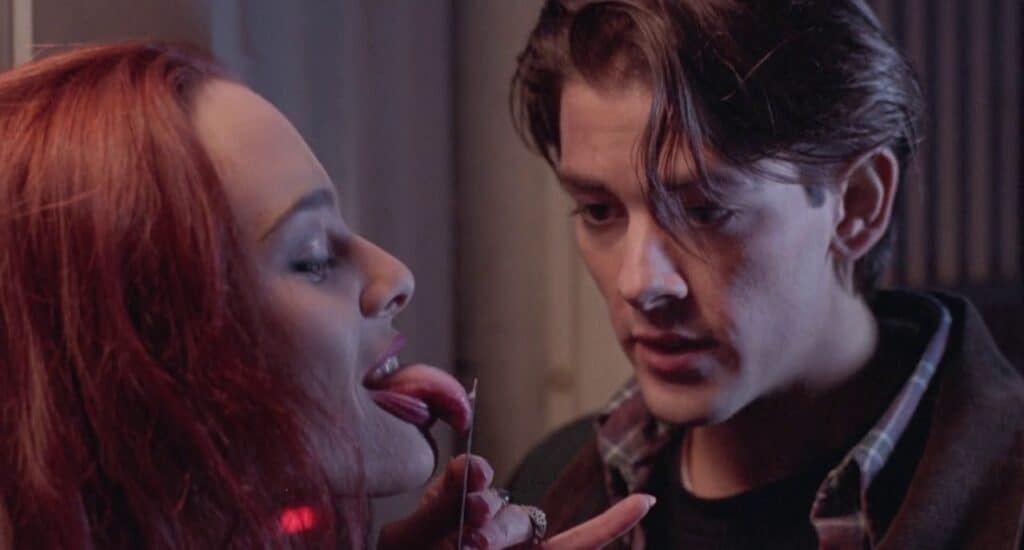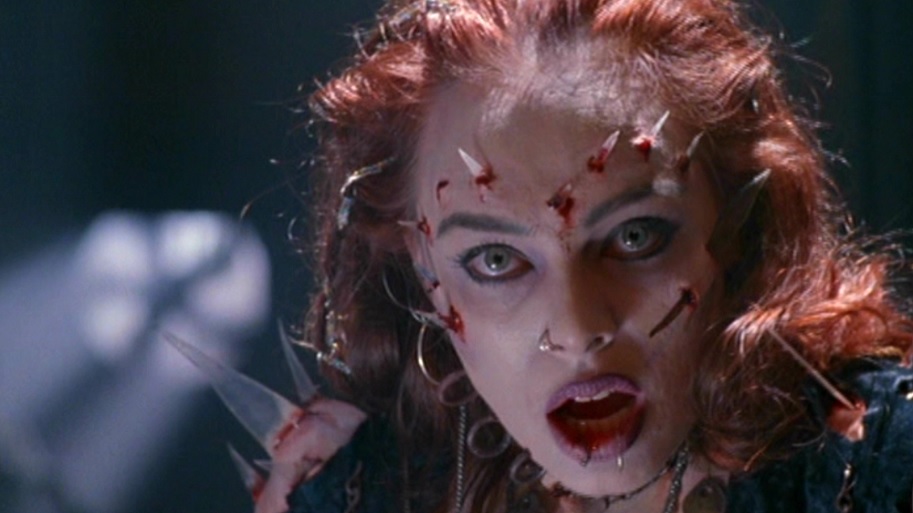When we last left the Return of the Living Dead franchise, Part 2 had just flopped badly, satisfying neither critics nor fans of the first one. Making only $9 million worldwide after a $6 million budget, what was once thought to be a burgeoning series of movies in the mold of Friday the 13th looked deader than a week-old corpse. But as we all know, you can’t keep a good zombie down, and after the man who held the rights to the Living Dead name, Tom Fox, decided he didn’t want to be in the ghoul business any longer, he sold the rights, which eventually ended up at Trimark Pictures, a small studio specializing in horror pictures like Warlock, Leprechaun and Peter Jackson’s Dead Alive. Trimark saw there was potential still pumping in the Living Dead’s veins and decided to make a third entry, although this one would be far removed from the scare-less slapstick seen in the last installment. Trouble was, they didn’t have much time to re-animate this zombie – so they hired a Re-Animator to do it. Grab a bucket of brains but don’t prepare to laugh too much – this is gonna be serious business as we delve into WTF Happened to Return of the Living Dead III.
When Trimark acquired the rights to the Living Dead franchise, it came with a caveat: they had to make the movie before the end of 1993 if they wanted to retain said rights. The CEO of Trimark, a man named Mark Amin, reached out to Brian Yuzna, best known as Stuart Gordon’s producer on Re-Animator and From Beyond and the director of Bride of Re-Animator and the ultra-nasty Society, the latter film a particular favorite of Amin’s. Clearly, Yuzna knew his ghouls and grotesqueries, so he’d be the right man for the job. When hired, Yuzna was evidently free to do what he wanted with the new picture – the studio only had two stipulations: he must include the deadly gas Trioxin – which would link this movie to the last two – and the zombies must eat brains, as that’s their calling card in this franchise. With those mandates in mind, Yuzna went about searching for a writer to collaborate with. The pitch he liked best came from a fellow named John Penney, who’d worked on the first Living Dead as an assistant editor. Penney proposed a story inspired by Romeo and Juliet, where two kids in love find themselves torn apart by the toxic gas that reanimates corpses. Yuzna had always regretted not featuring the “Bride” more in his Bride of Re-Animator and cozied to the idea of making one of the main characters a zombie, someone who’d tragically realize that they were dead and turning into a brain-craving monster.
Yuzna was a big fan of Dan O’Bannon’s first film and felt obligated to keep some of its demented spirit in the new one, but ultimately he decided the film should have a straight-forward, grim tone that would set it apart from the first two. He and Penney worked closely on the script, which was being written so fast that Penney was still writing during the actual production of the movie. As they had to make the movie before the end of the year, production was to begin in October and wrap the following month. All told, they had $1.5 million and 24 days to make Return of the Living Dead III.

One new twist Yuzna brought to the table was an explanation regarding just why the zombies in this universe crave brains in particular. While he wasn’t enthralled with the gimmick, he felt the need to give it some added backstory, reasoning that the zombies thrive on the electricity in the neurons of humans, hence the brain would be the ultimate meal. Next he figured the military – which figured prominently in the first two films – should reappear here as more of a hands-on antagonist, as it’s their mission to use the living dead as weapons of war. With this in mind, the story would revolve around two teenagers – Curt and Julie – who find themselves up to their ears in horror when Julie dies and Curt has the bright idea of reviving her using the Trioxin gas. Things don’t go exactly as planned, to say the least, and the two find themselves fleeing the army as well as a gang of psychos all while trying to deal with Julie’s newfound hunger for flesh and brains.
Once Julie is brought back to life, everything hurts – especially her broken neck. In Penney’s original drafts, much was made of the neck’s nasty appearance, but a screening of Robert Zemeckis’ Death Becomes Her – which prominently features a broken neck gag – resulted in Penney ignoring that aspect of Julie’s broken-down body.
Yuzna’s main concern was that the audience sympathize with Julie’s horrific plight as opposed to finding it humorous. Previous movies he’d made like Re-Animator and Society had ample helpings of dark humor, and he wanted to avoid that here, instead going after a tone that he’s quoted as calling “stupid and fun, but played straight.” At one point, the production tried to bring back James Karen and Don Calfa – two over-the-top highlights from the first film – but when that didn’t work out, they decided that was for the best, as they wanted to limit the light-heartedness as well as make this new film stand on its own.
Crucial to the effectiveness of the movie’s somber tone would be the lead actors playing Julie and Curt. Julie is the main show here, and getting her just right was critical. Enter Melinda Clarke – known as Mindy Clarke then – who’d only had a handful of credits to her resume at the time. One role that proved vital to her connection with Julie was a stage play based on the exploits of Sid Vicious and Nancy Spungen; playing the latter offered Clarke some insight into a person who lived life as close to the edge of death as possible. Clarke was not a big fan of horror movies, but she appreciated the special effects in them – something that would come in handy later in the production when her character completely transforms herself.
To play boyfriend Curt, the production brought on J. Trevor Edmond, who had a special relationship to the Living Dead franchise. As a teenager, Edmond worked in a movie theater and snuck into Living Dead Part 1 so many time that he got fired because of it. When he eventually found out they were making a second movie, he and his pals drove around L.A. trying to find the set so they could ask to be a part of it. Now he had his chance, playing a character that acts with his heart and not his brain… which could very well get his brain put on the menu.

Production was so tight on the film that they hired five different make-up effects companies to produce the various ghouls, gore gags and whatever other splatter was needed. Heading up the main unit was the legendary Steve Johnson, who’d rose up the ranks in the industry thanks to contributing frightening effects to movies like American Werewolf in London, Videodrome and Night of the Demons, just to name a few. Johnson was to be responsible for the most stand-out effects design in Living Dead 3, that being the transformed Julie, who mutilates and remakes herself into something of a zombie Cenobite. Utilizing over 100 separate pieces of prosthetics, putting everything on Mindy Clarke initially took nine hours to finish; later they got it down to six, but such a process could drive anyone nuts. For her part, Clarke admitted the ordeal was exhausting but necessary, noting that she’d likely never get the chance to do something like it again.
While the make-up guys did their thing, Yuzna had to work hard and fast to get the film completed. Two separate units were shooting simultaneously, the A-unit for the actors and main monster work, the B-unit covering all the secondary zombies and other horrors. Many of the ghouls seen in the movie took less than a couple weeks to design and build, but with five different crews focusing on different gags, they were able to get it done in the short schedule they were given.
Looking forward to what he knew would be a battle with the MPAA, Yuzna had the foresight to shoot the movie with both R-rated and unrated versions in mind. Hence, instead of just shooting the gory stuff and waiting to cut it down later, Yuzna would shoot takes where all the gore was on display and takes that weren’t as nasty. This strategy ensured that the audience watching the R-rated version would still get the same intended effect of the bloody sequence without missing large chunks of the scene.

Still, with the MPAA being who they are, there were still plenty Yuzna had to dial down even in the R-rated version. As the MPAA doesn’t like torture or mutilation, scenes where characters are getting egregiously torn to shreds had to be whittled down. For example, a ghoul stabbing a guy with a scalpel once was fine, but stabbing him over and over again was not. Same for a sequence where a bitten lip is pulled to a ridiculous extreme – anything super over-the-top had to go. Yuzna claimed he had to make about 50 changes for the R-rated version he’d already been careful about, but in the end the R-rated and unrated versions ended up being almost the exact same length.
Not everyone would be watching the R-rated version, however. Down in South Africa, the powers that be decided the movie had an “evil force” in it and it was banned outright. Meanwhile, the unrated version went out to other foreign territories where the countries could cut from the film what they wanted. In some territories, the film was released as Mortal Zombie, a title Yuzna prefers to Return of the Living Dead III to this day.
While initially planned for a modest theatrical release, Return of the Living Dead III only received a very limited one; this due in part because Trimark’s other horror sequel of the fall, Warlock: The Armageddon, flopped out of the gate, grossing only $1 million. Living Dead 3 only ended up grossing around $54,000 during its truncated release, but certainly found its fanbase on home video where the unrated version ended up doing quite well.
Over the years, Return of the Living Dead III has acquired a very loyal cult of fans who appreciate its tragic love story, its vivid gore effects, and perhaps most of all, its iconic leading lady and her unforgettable fashion sense. A blood-soaked take on Romeo and Juliet is hard to resist, especially when Juliet has this much bite.
A couple of the previous episodes of the show can be seen below. To see more, head over to our JoBlo Horror Originals YouTube channel – and subscribe while you’re there!
The post Return of the Living Dead III (1993) – What Happened to This Horror Movie? appeared first on JoBlo.
No comments:
Post a Comment